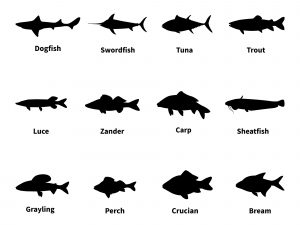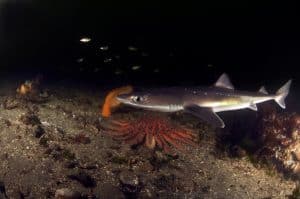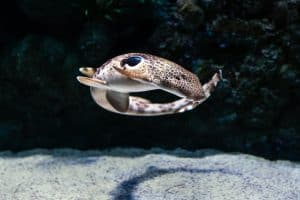The long-haired dogfish (Squalus suckhami) is a species of ray in the shark family that has been around for millions of years. The name “dogfish” comes from its fierce look, which is why people used to call them “dogs”.
Although they are known as sharks, most dogfish don’t swim like sharks. They move slowly by using their pectoral fins to propel themselves forward. If you’re ever swimming with one, you’ll notice how gracefully they move through water without any splash or noise.
They also have large eyes and small mouths, so they only feed on plankton and other tiny creatures. This means that they don’t need to constantly keep moving to catch prey, unlike some sharks.
So if you’re interested in trying your luck at catching this elusive fish, read on! We will discuss everything about dogfish, including where to find them and whether you should be able to eat them.

Dogfish facts
Scientific name: Squalus suckhami
Nickname: Suckerpunch
Common names: Longnose conger eel, longnose hogfish, longnosed hogfish, longnose hoggar, longnose squiggle eel, longnose squirrelfish, pighead sea scorpion, pighead sea stingray, pigheaded seabream, suckerpunch, spotted hogfish, spottetail hogfish, spotted hoggar, spotted hogfish, yellowbelly hogfish, yellowtail hogfish, yellowtail hoggar, yungong mudskipper, yungongsudskipper
Height/weight: Up to 30 inches (75 cm), up to 15 pounds (6 kg)
Food preferences: Plankton, small crustaceans and mollusks, bivalves, clams, worms, brine shrimp
Habitat: All oceans except polar regions and deep ocean trenches
Distribution: Tropical waters throughout the world except Australia and Antarctica
Temperament: Aggressive but shy
Lifestyle: Nocturnal, slow movement
Diet: Plankton, small crustaceans and mollusks, bivalves, clams, worms, brine shrimp
Interaction with humans: Rarely interact with humans because they mostly stay away from human activity
Interesting Facts About Dogfish
Long noses help these animals sniff out food sources. Their snouts are actually sensitive organs that pick up scents. To add more substance to their nose, they use muscles along their snout to push the air upward.
Their teeth grow continuously throughout their lives. These teeth continue growing until an animal reaches maturity, after which time they stop growing completely.
Unlike many sharks, dogfish do not have gills. Instead, they breathe through two types of pores called spiracles. One type sits near the bottom of the body while the other is located closer to the head.
Some experts believe that the largest dogfish could weigh over 22 pounds (10 kilograms).
Where can you find dogfish
You might think that since dogfish live in tropical and warm seas all over the globe, they would be found anywhere. But that isn’t true. There aren’t even any records of dogfish living off the coasts of Australia or Antarctica.
In fact, the closest place where you can find them is in the Caribbean Sea between Mexico and Panama. In North America, the only place they inhabit is Hawaii.
Because of this, finding a wild one is extremely difficult. Even when caught, you won’t know what kind of dogfish it is unless you’ve seen it before.
However, if you want to try your hand at fishing, you can buy a live one from a local pet store. Just make sure you choose a healthy specimen, as they usually come with tags.
It is important to note that if you decide to purchase one, please follow the guidelines outlined in our article about buying seafood online.
If you’re lucky enough to see one, you may mistake it for another similar species with similar coloration such as sandbar hogfish (S. microcephalus). Or maybe you’ll even get confused and confuse it for an anglerfish (a parasitic flatworm).
Can you eat dogfish
Yes, you can eat dogfish. Although they appear unappetizing and scary, they are actually delicious. And you can enjoy eating dogfish year round regardless of season.
One thing to note is that dogfish contain high levels of mercury. So it’s best to limit your consumption to once every three months.
But if you still want to give it a shot, here are some tips to prepare and cook dogfish.
How does dogfish taste
To test the flavor of dogfish, I bought a few fresh ones from my local grocery store. I then prepared them according to the instructions listed below.

How to fillet dogfish
First, let’s talk about preparation. If you want to serve it raw, you must first remove the scales. Then cut the flesh into pieces of equal size and flatten each piece horizontally. Next, slice the flattened meat vertically down the middle. Finally, separate the slices using your fingers.
Now, let’s move onto cooking. First, heat some oil in a pan. Afterward, sauté the sliced meat for 10 minutes.
Next, transfer the cooked pieces to a pot filled with enough water to cover them. Boil them for another 20 minutes. Once done, drain the liquid and pour it back into the pot. Add salt and pepper to taste.
Finally, stir the meat again and put it in serving bowls. Serve immediately with hot sauce and garnish with lemon wedges.
How to cook dogfish
If you prefer to roast your dogfish instead of boiling them, just follow these simple steps:
Preheat oven to 400 degrees Fahrenheit (204 degrees Celsius). Rinse the cleaned fish under cold water and pat dry. Place the fish inside a baking dish lined with foil and brush lightly with olive oil. Sprinkle with salt and pepper.
Roast the fish for 12 to 18 minutes depending on thickness. Let cool slightly, then peel away the skin. Chop finely and serve alongside mashed potatoes, polenta, or pasta.
Note that dogfish contains toxins that are harmful to humans. As such, always take proper precautions when working with them. For example, wear gloves and wash your hands thoroughly after handling dogfish.
Recipes featuring dogfish
I’m going to share with you two recipes that I tried recently. Both were easy and quick to prepare, and both tasted good.
Spotted hogfish stew
Ingredients:
1 pound (450 grams) spotted hogfish, cubed
2 tablespoons extra virgin olive oil
1 medium onion, diced
3 cloves garlic, minced
4 thyme sprigs
1 bay leaf
Salt and freshly ground black pepper
5 cups chicken stock
Directions:
Heat the olive oil in a Dutch oven over medium heat. Add the onion and garlic and sauté for 5 minutes.
Add the thyme, bay leaf, and 1 teaspoon of salt and bring to a boil. Lower the heat and simmer for 8 minutes.
Strain the broth through a sieve, discarding the solids. Set aside.
Season the fish with salt and pepper. Cook in the oil over medium heat in the Dutch oven for 3 to 4 minutes per side until golden brown. Transfer the fish to a plate and set aside.
Reduce heat to low and add 2 teaspoons of butter. Saute the onions for 5 minutes. Deglaze the pan with ¼ cup of red wine vinegar and scrape up the brown bits in the pan with a wooden spoon.
Return the fish to the pan along with the strained broth, the remaining ½ cup of white wine, and the reserved onion mixture. Bring to a gentle simmer and cook uncovered for 7 to 9 minutes or until the fish is opaque.
Remove the fish to a platter, tent loosely with aluminum foil, and allow to rest for at least 5 minutes. Discard the bay leaves. Serve with steamed rice.
Baked cod with bacon, tomatoes, and fennel
Ingredients:
12 ounces thick cod fillets, rinsed and dried
Olive oil
Coarse salt and freshly ground black pepper
½ cup chopped shallots
2 cloves garlic, thinly sliced
1 tablespoon tomato paste
1 cup halibut milk
¾ cup shredded fennel
4 strips of bacon, cut crosswise into thirds
8 cherry tomatoes, quartered
Fresh basil leaves, for garnishing
Directions:
Preheat oven to 425ºF (220ºC). Coat a 13 x 9-inch baking dish with nonstick spray or coat with cooking spray. Season the fillets generously with coarse salt and pepper. Lay the fillets in the dish, overlapping them somewhat. Brush each fillet with olive oil. Cover tightly with foil and bake for 25 minutes. Remove the foil, flip the fillets over, replace the foil, and bake until it reaches your desired consistency.

Conclusion
So can you eat dogfish? While it isn’t the most accessible fish in the world, if you manage to get your hands on one, you can most definitely eat it. Maybe try one of the recipes above and form your own opinion about its taste.
Finally, also have a look at our articles on alternative fish to eat, e.g.: channel catfish, tarpon, ladyfish, sculpin or sheepshead.